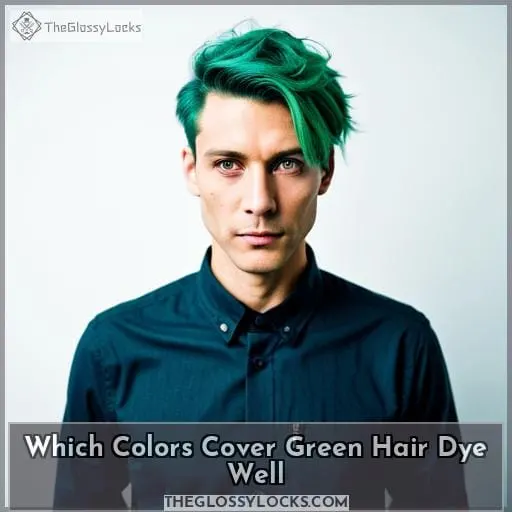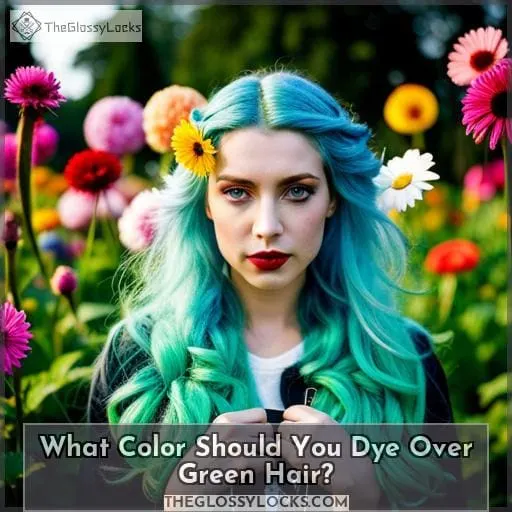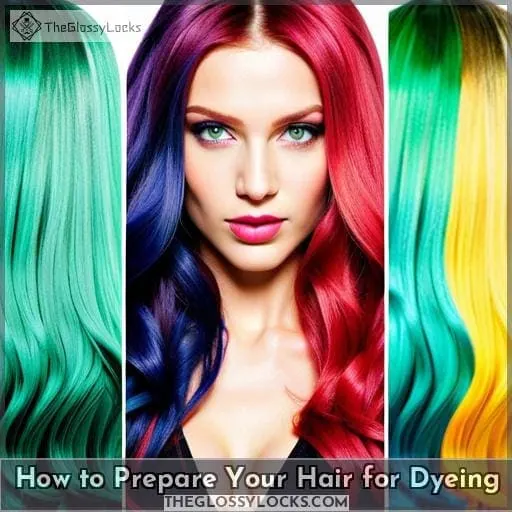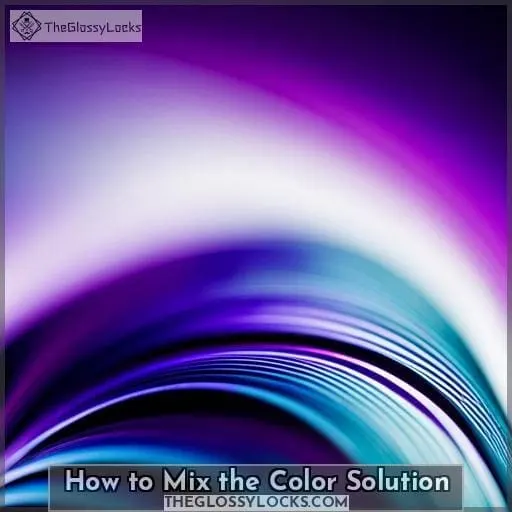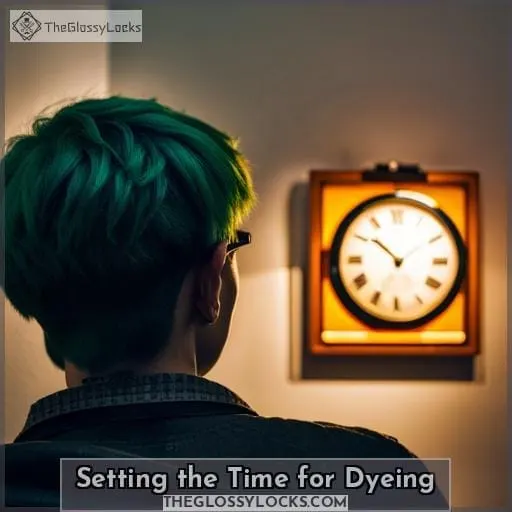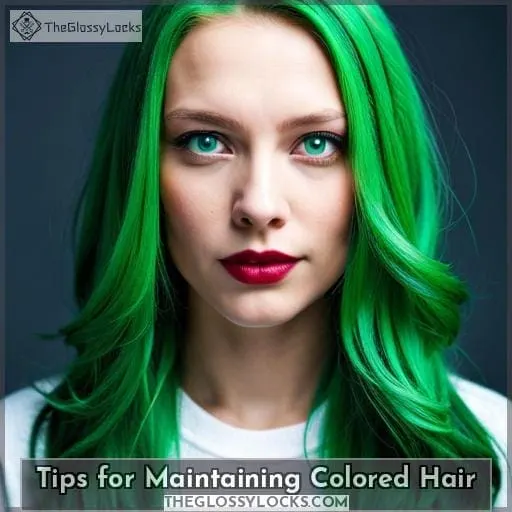This site is supported by our readers. We may earn a commission, at no cost to you, if you purchase through links.
Are you feeling like a destitute green-haired monster? Have you had enough of the Kylie Jenner look and want to switch it up? Well, don’t despair.
As they say, when one door closes, another opens. So if you’re ready for a change in style and color, here’s what you need to know about dyeing over green hair. We’ll discuss which colors cover green best, as well as tips for maintaining colored hair.
Keep reading and let’s get started on this journey together!
Table Of Contents
- Key Takeaways
- Which Colors Cover Green Hair Dye Well
- What Color Should You Dye Over Green Hair?
- How to Choose the Right Shade of Purple
- How to Prepare Your Hair for Dyeing
- How to Part Your Hair for Dyeing
- How to Mix the Color Solution
- Setting the Time for Dyeing
- Common Mistakes to Avoid When Dyeing Hair
- Natural Home Remedies for Removing Green Tones
- Tips for Maintaining Colored Hair
- Frequently Asked Questions (FAQs)
- Conclusion
Key Takeaways
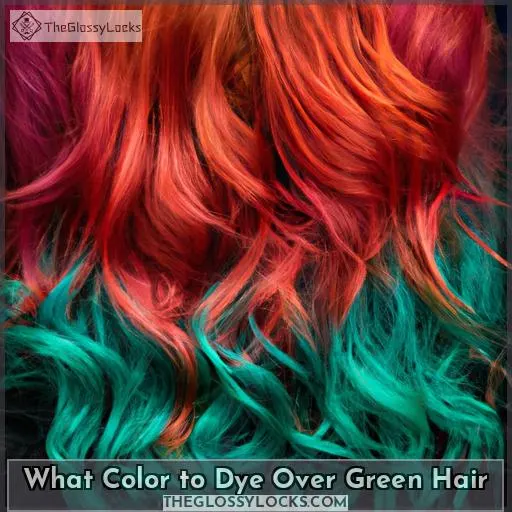
- Purple, blue, orange, and brown are all good options for covering up green hair.
- Warm red-orange hues cancel out cool blues and greens, while cooler ones work better against warm yellowish tints.
- Professional colorists know which product works best with which hair type and how much direct application is necessary for the desired result.
- Darker colors such as blue, purple, orange, and brown can be used to dye over green hair without bleaching.
Which Colors Cover Green Hair Dye Well
Are you looking for the best colors to cover up your green hair dye? Look no further! Blues, purples, oranges, and browns are all excellent choices for masking off the green. To ensure a great result, it’s important to mix your color components in the right ratio as specified by the manufacturer’s instructions on its packaging.
Conduct a strand test before completely dying your hair with any of these shades.
For professional results, consider consulting with a skilled colorist who knows how to use new products and techniques efficiently without damaging hair too much. After all, they understand how difficult it can be working with chemically colored strands, which tend to become more porous over time.
Red tones are also powerful in canceling out those greens, so if that’s what appeals most, then go ahead and try them out! Keep in mind, though, that warm red-orange hues cancel out cool blues/greens while cooler ones work better against warm yellowish tints, such as when bleaching goes wrong or due to environmental factors like chlorine or sun exposure affecting blonde locks, turning them into an unwanted shade of aqua-green.
In short, there is no one solution that fits all here since each person has different needs. Rest assured, though, there are plenty of options available depending on individual preferences. Just make sure not to overdo heat styling tools or wash dyed locks too frequently.
Otherwise, fading might happen sooner than expected, leaving behind unsightly patches where once beautiful vibrant colors were shining through. This isn’t something anyone would ever wish for, so take care when dealing with already treated manes.
What Color Should You Dye Over Green Hair?
When changing your hair hue, consider masking the green shade with intense purples or dark browns for a successful result. In fact, purple is reportedly the most popular choice to cover up green tones. To achieve this look without damaging your hair too much, you can overlap the existing dye with an appropriate colorant.
Blue, purple, and orange are all good options when it comes to covering up a noticeable amount of green strands.
Brown is also another great option if you want something more subtle than bold colors such as blue or purple. However, make sure that it’s darker than what you currently have now – otherwise, it won’t be effective at hiding unwanted hues.
Additionally, warm red-orange tones are opposite to cool shades like greens and blues, so these could help neutralize any undesirable undertones from appearing again in future washes.
Good news: If there are only small patches of discoloration, then highlights can be used instead! You may also opt for pink dye, but just remember that this should always be darker compared with your current shade since lighter pinks won’t necessarily hide away unsightly tints very well either.
The key here is finding a product that complements both skin tone and style while still giving off an air of sophistication.
How to Choose the Right Shade of Purple
Making the switch from green to purple can be tricky, so it’s important to choose the right shade for you. Purple tones are great for covering up green hair and creating a unique look. When selecting a dye, consider your type of hair dye as well as any treatments you may have placed on your locks prior.
- Start by washing hair with warm water without using harsh shampoos or conditioners before applying color solution;
- Mixing components in the correct ratio is essential when coloring – use 1 part colorant mixed with 2 parts developer;
- Consider alternatives such as purple highlights if not wanting the entire head colored;
- Touch up every 4 weeks depending on the current desired shade;
- Seek help from skilled professional colorists – they know which products work best!
Taking extra steps like these ensures less chance of damage while still achieving desired results quickly and efficiently.
How to Prepare Your Hair for Dyeing
Now that you’ve chosen the perfect shade of purple to dye over your green hair, it’s time to prepare your locks for a new look. Pre-dyeing care is essential if you want a color that won’t damage or fade quickly.
Start by selecting the right hair colors and mixing them in the correct ratio according to package instructions.
Once ready, begin with clean, dry hair and use protective gloves during application since this will help avoid staining skin or nails.
Finally, remember not every step needs chemical coloring – sometimes simply bleaching can do most of the work for you. Just make sure whatever type of bleach bath used is suited exactly for your kind of green hue if trying this route instead.
When done correctly, following these steps should have kept environmental factors from turning blonde strands an undesired shade.
How to Part Your Hair for Dyeing
Before you begin dyeing your hair, carefully part it into sections where you want to apply color for a more even application. Start by brushing or combing out any knots and tangles before dividing up your hair.
Depending on whether you are using heat tools or not, it will determine how much time should be spent parting the strands.
When choosing what colors suit best, try matching shades that complement green tones while also providing an option of highlighting with brighter dyes if desired. Professional products may provide better results than those found in stores. Additional protection items like gloves should always be worn during the application process to avoid staining skin from direct contact with product components such as developer or coloring agents.
Picking which hue suits best over green hair color can result in striking locks full of vibrancy and depth! Remember though, when selecting bold hues like purple, orange, browns, etc., make sure they fit within a similar tone range so that they match together well.
To ensure safe practices at home, use only trusted brands such as L’Oréal Paris Feria Multi-Faceted Shimmering Permanent Hair Color, which offers gentle formulas designed specifically for colored tresses.
How to Mix the Color Solution
You need to be precise when mixing the hair color components, as the old saying goes: measure twice, cut once. The length of your hair and desired maintenance will determine how much you mix in order to achieve a successful outcome.
Most home kits contain instructions for mixing all contents together but if you only want a little on certain areas then it requires different instructions.
When dyeing over green with another bright color like purple or maroon, overlapping the green dye with an intense shade of purple works best – try adding some highlights too! Whatever method you choose, ensure that each step follows crucial instructions such as washing your hair a few days before coloring and setting aside enough time before rinsing off the product (usually around 40 minutes).
It might take several attempts, but eventually finding what works best for canceling out greens should help keep colored locks looking their vibrant selves into summertime too – just remember not to overuse heat styling tools, which can damage chemically treated tresses further.
Setting the Time for Dyeing
Once you’ve mixed the solution, it’s time to set a timeframe for your coloring adventure! It’s important to pick an appropriate amount of time as this will affect the outcome of your hair. A strand test should be conducted prior to dyeing all over in order to understand what results can be achieved and how long it may take.
The skills of a good colorist are paramount here. They know which product works best with which hair type, as well as how much direct application is necessary for the desired result. Purple shampoo cannot fix green hair, so selecting another bright hue such as purple or maroon that complements skin tone and style is recommended instead.
Colors like blue, purple, orange, or brown tend to work better than blonde shades when masking off green tones. Warm reddish-orange tones on the color wheel help cancel out any unwanted green hues too.
Finally, always remember that no matter what happens during the coloring process, hair health comes first! Hence, proper mixing ratio between developer and colorant components according to package instructions must not be neglected if you wish to prevent damage caused by the chemical reaction from taking place within strands themselves.
Common Mistakes to Avoid When Dyeing Hair
When dyeing your hair, there are a few common mistakes you should be aware of to ensure the best results.
Firstly, make sure that you choose the right color for your desired look. Coloring over green hair with another shade of green will not achieve a desirable result.
Secondly, avoid coloring directly onto the scalp as this can lead to dryness and irritation.
Thirdly, don’t keep the dye on for too long or it may cause damage to your strands.
Additionally, keep in mind that certain shades won’t work well with certain skin tones, so select accordingly.
Finally, remember that heat styling tools used at high temperatures can strip away some of those beautiful colors!
Choosing the Wrong Color
Choosing the wrong color for your hair can be disastrous, so it’s important to do research and pick a hue that complements your skin tone and style. When transitioning from green to purple, intense purple is essential. Destitute green-haired monsters can be avoided by selecting the right shade of emerald or maroon.
If you’re using black hair dye mix, opt for red shampoo instead. It counterbalances the color of green hair better than purple! Color theory must also be taken into consideration while picking shades.
Warm hues like orange are most effective in canceling out cool tones such as blue or grey.
Coloring Your Scalp
Just be sure to take extra care of your scalp when you’re coloring it! A strand test is always a good idea before attempting any major hair color transformation. Knowing the science behind hair color and understanding the use of colors on the wheel can help prevent scalp damage.
Regularly using purple shampoo or home remedies like vinegar rinse can also preserve natural colors and brighten up green hair looks. Remember, don’t overdo heat styling tools when transitioning from one shade to another.
Blow dryers are not your friend! Take advantage of professional advice for best results without compromising your precious locks’ health.
Keeping the Color on for Too Long
If you’re feeling daring, don’t let your bold hair color choice stick around for too long – or else you could end up looking like a monster! The long-term effects of green dye can be unpleasant, and unnatural hues may appear.
Fading green requires careful attention to minimize damage. Red-orange tones are effective in canceling out the hues, while purple dye masks them off well. Hydrogen peroxide and vitamin C can also help break down the dyes faster, but they should be handled with caution as they may cause further hair damage.
Choosing Shades That Don’t Compliment Your Skin Tone
When selecting a hair color, it’s important to consider your complexion as certain shades may not flatter it. If you have green undertones, you can mask them with other bright colors like purple or maroon.
Red dye can also be used to lessen green if needed, and warm red-orange tones are opposite of the color wheel’s green-blue colors. For added depth without committing too much, try subtle purple highlights instead of full coverage.
Hot pink highlights are a great way to add life while maintaining naturalness in lighter complexions. However, it’s important to also consider environmental factors when selecting a shade for lasting results.
Lemon juice mixed with water can help reduce yellow or even green tints that come from chlorine and sun exposure, but be careful not to leave it on for too long.
Overusing Heat Styling Tools
You should be extra careful when using heat styling tools on colored hair, as they can cause major damage and strip the vibrant hues from your locks in an instant! Be sure to match colors correctly for best results and avoid bleaching or overusing purple shampoo.
Follow dye ratio instructions carefully and wait the recommended period before rinsing off. If needed, consult with hair professionals to get advice on how to safely remove excess dye or which shades are best for covering green tones.
Natural Home Remedies for Removing Green Tones
You may be surprised to learn that some common kitchen ingredients can help remove green tones from your hair. Yes, really! Ketchup for green hair? A vinegar rinse is another simple and cost-effective option.
You could also try a baking soda paste or a clarifying shampoo for better results.
Ketchup for Green Hair? Yes, Really!
Surprisingly, ketchup can be an effective way to neutralize green-tinged locks! It’s an excellent option for those looking to make a dramatic change without compromising the integrity of their hair. Ketchup benefits from its earthy tones and warm red pigment, which oppose the blue hues found in green hair.
It’s great for adding subtle purple highlights or deepening existing colors on the color wheel theory.
Whether you’re transitioning from blue/green to brown or lightening up dark shades, you’ll find yourself entering a whole new world of hair color with this DIY solution! Opposite hues are your friends when it comes time to take care of pesky green tresses, so don’t hesitate – break out that bottle today!
A Vinegar Rinse
Refresh your radiant locks with a vinegar rinse and watch the green tinge fade away! Vinegar is a natural remedy that contains acetic acid, which can help remove excess dye from hair. For best results, mix equal parts of apple cider vinegar, lemon juice, and water.
However, using this method excessively can cause damage to your hair. Use it every few weeks to maintain healthy strands while bidding farewell to the color of envy with just a little bit of effort and care.
Baking Soda Paste
Try a baking soda paste to help strip away the green tinge without harsh chemicals. Mix equal parts baking soda and water, then apply it evenly on dry hair. Leave the mixture for 15 minutes before rinsing with cool water.
Consider using a vinegar rinse as well after dyeing your hair, as this will further reduce any remaining green tones and ensure you get the best results from your new interpretation of the latest green hair fashion trend! Don’t forget to do a strand test before applying any color all over.
Clarifying Shampoo
For a quick fix, use clarifying shampoo every couple of weeks to gradually reduce the intensity of green tones in your hair.
Find the most efficient hair products that are suitable for your hair type. Make purple or red dye your best friends when trying to cancel out green hues.
Common mistakes include using purple shampoo instead, which won’t solve any problems related to getting rid of unwanted color tints.
Tips for Maintaining Colored Hair
If you are looking for tips on maintaining colored hair, especially when transitioning from green to purple, then look no further. To keep your hair healthy and vibrant between dye jobs, it is important to avoid using heat styling tools as well as overusing chemicals.
Additionally, touch up the color with a semi-permanent hue that matches the desired shade in order to maintain vibrancy and richness in color. Lastly, use professional products recommended by hairdressers when washing your hair and do not overwash since this can strip away some of its natural oils.
Avoiding Heat Styling Tools
Avoid using heat styling tools on chemically colored hair as they can damage the already porous and vulnerable strands. Heat damage may cause color fading or an undesirable green shade to appear in your hair.
Purple shampoo will not fix this issue. A strand test is needed before mixing any entire contents from home kits. The experimental nature of coloring your hair requires extra caution and attention when it comes to avoiding heat styling tools for best results.
Touching Up Purple Hair
Touching up your purple hair every 4 weeks will keep it looking vibrant and healthy. For the best results, make sure to perform a strand test before coloring. Use colors opposite of green on the color wheel, such as red-orange.
Maintain your hair with regular care, such as using clarifying shampoo or vinegar rinse. Purple highlights are also an option if you’re not ready for a full transformation! To counterbalance yellow/green tones in blonde locks, use red shampoo.
However, transitioning from green to purple takes roughly 40 minutes, so proper planning is necessary.
Transitioning From Green to Purple Hair
If you’re ready for a new look, transitioning from green to purple hair can be done quickly and easily.
To start off, do a strand test before bleaching green hair. Masking colors such as blue, purple, or orange work best in covering up the hue. For an even faster transition, add some red shampoo or try out purple highlights instead! Keep in mind that overlapping intense hues is key, and heat styling tools should always be used with caution on colored locks.
Using Professional Hair Products
Try investing in professional hair products to help you transition from green to purple hair quickly and effectively. Beware of using at-home remedies as they can result in significant damage. Make sure the dye ratio is correct and do a strand test before application! Utilize toning shampoo after coloration, use colors on the opposite side of the color wheel to cancel out green hues, and practice good maintenance habits such as avoiding heat styling tools regularly.
Avoiding Overuse of Chemicals on Hair
You must be mindful of the amount of chemicals you use when transitioning from green to purple hair, as overuse can cause chemical damage and color fading. Prioritize hair health by incorporating deep conditioning treatments and avoiding excessive heat styling.
Consider adding subtle purple highlights instead of fully dyeing your hair for a more gentle transition.
Remember that healthy, well-maintained locks are essential in achieving any desired hairstyle without causing long-term damage to your strands.
Avoiding Overwashing Hair
Avoid washing your hair too frequently, as it can strip away natural oils and cause color fading. Overwashing hair leads to unnecessary damage that could result in green hues showing through purple highlights or masking colors used in the color theory process.
To maintain colored hair, use a strand test before dyeing all over and keep touch-ups regularly spaced out every four weeks. Avoid heat styling tools on chemically colored locks for best results – air dry instead! Purple shampoo does not fix green issues; only red shades cancel out unwanted tones in the end.
Frequently Asked Questions (FAQs)
What type of dye should I use to cover my green hair?
If you want to make a statement with your hair, consider using blue, purple, orange, or brown dyes as they cover green hair well. For best results, mix the color solution according to the package instructions and remember not to leave it on for too long! Using heat styling tools should be avoided for chemically colored hair.
How often should I dye my green hair to maintain the color?
Dyeing green hair to maintain its color should be done every four weeks. The most effective method for keeping vibrant and healthy-looking locks is to apply a new layer of intense purple dye. To achieve your desired results with minimal damage, it is recommended to regularly use hydrating shampoo or conditioner, avoid excessive heat tools, and perform strand tests.
What are the best methods for fading green hair?
Fading green hair can be a tricky task, but with the right approach, you’ll have it looking like old news in no time. To ensure your efforts pay off, use professional products and avoid heat styling tools.
Clarifying shampoo every couple of weeks will gradually lessen its intensity, while a baking soda paste or vinegar rinse may also help lighten it up.
How do I prevent green hair from happening again?
To prevent green hair from happening again, avoid exposure to chlorine and UV rays. Before using styling tools, apply a heat protectant. Opt for semi-permanent or demi-permanent dyes to counteract any yellow or green tones.
Use gentle shampooing techniques and choose colors that complement your style and skin tone.
Is it possible to dye over green hair without bleaching it?
Yes, it is possible to dye over green hair without bleaching. Darker colors such as blue, purple, orange, and brown can be used as they cover the green shade well. It is recommended to conduct a strand test before applying the color all over for the best results.
Achieving the desired outcome can also be aided by mixing the components in the right ratios. After dyeing, use gentle heat treatment and products specifically designed for colored hair to achieve a healthy shine.
Conclusion
You have the power to transform your green hair into a new, beautiful look. By following the tips given in this article, you can make the switch from green to purple with ease.
Start by selecting a shade that complements you. Then, prepare your hair for dyeing by using the right mixture of color components. Part your hair in the right way and wait the recommended time before rinsing off the color.
To keep your hair healthy and vibrant, use products designed for colored hair and avoid overusing heat styling tools. Finally, use natural remedies like a vinegar rinse or baking soda paste to remove any excess green.
With these tips, you can create a stunning purple look and get the most out of your hair.

